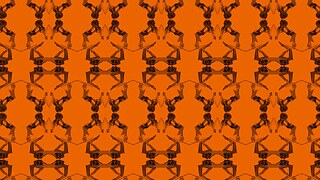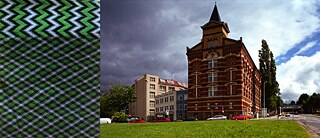Is AI a tool or an autonomous agent?
Key historical developments from the First to the Fourth Industrial Revolutions have laid the groundwork for artificial intelligence. But how does the AI of today impact on art and, consequently, what is art and what is an artist?
Like many things, artificial intelligence (AI) has a number of possible beginnings and trajectories. Equally, its use is open to many outcomes depending on who is doing the using and what or whom is subject to its use. It has been with us in some way since the 1940s, but with 5G we are entering a new more powerful phase where AI will have a significantly greater impact.
To start with a brief history; AI and its variants are an outcome of the mechanisation of work. Particularly relevant is the invention of the mechanical stocking knitting machine – the Stocking Frame in 1589, and its later developments which were at the forefront of the First and Second Industrial Revolution. The Stocking Frame was the first threat to cottage industry and the handmade by mimicking the movements of hand knitters and thus it was commonly the target of the Luddites. So, it can be argued, the stocking knitting machine was the beginning of robotics.
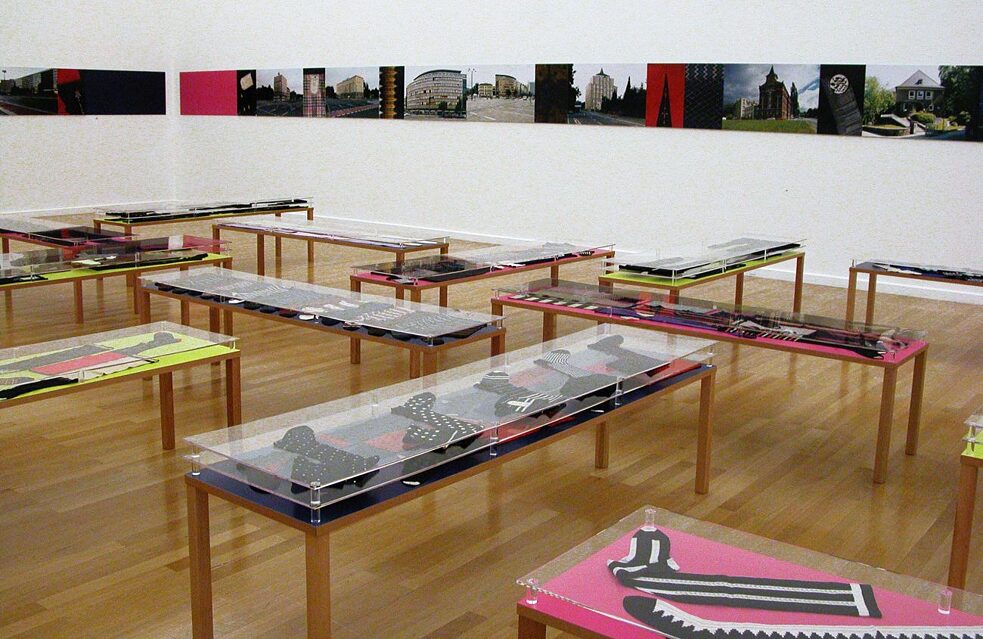 Installation of historic stockings and architecture at Kunstsammlungen Chemnitz, Germany
| © Richard Dunn
Installation of historic stockings and architecture at Kunstsammlungen Chemnitz, Germany
| © Richard Dunn
Mid-20th century mathematicians Alan Turing, Norbert Wiener, John von Neumann, Oskar Morgenstern were critical to the next phase of the Industrial Revolution. Turing had the concept of an abstract computing machine in 1935, elaborating on the technologies of the Industrial Revolution, however most developments followed World War II. In 1948 Turing wrote in Intelligent Machinery: “What we want is a machine that can learn from experience” with the "possibility of letting the machine alter its own instructions.”
In the same year Norbert Wiener introduced cybernetics, the transdisciplinary “study of control and communication in the animal and the machine". Cybernetics, from the Greek, meaning “governance” is related to James Watt’s regulated steam engine governor, the idea of corrective feedback. This is explained in The Human Use of Human Beings: Cybernetics and Society where Wiener writes with insight about art and artists.
He supports intellectual originality and inner conviction for creative artists as much as “scientific artists” and he criticises the commodification of art, model-following art and the social prestige of higher degrees. By the 1960’s London cybernetics had considerable currency in art with, for example, Jasia Reichardt’s Cybernetic Serendipity exhibition at the Institute of Contemporary Art and artist Roy Ascott’s article Behaviourist Art and the Cybernetic Vision.
In discussing originality and the original versus the copy, Wiener brings to mind Walter Benjamin’s 1935 discussion of the aura of original works of art in his The Work of Art in the Age of Mechanical Reproduction where aura was subject to and diminished by the mechanical or technical reproducibility of photography and film.
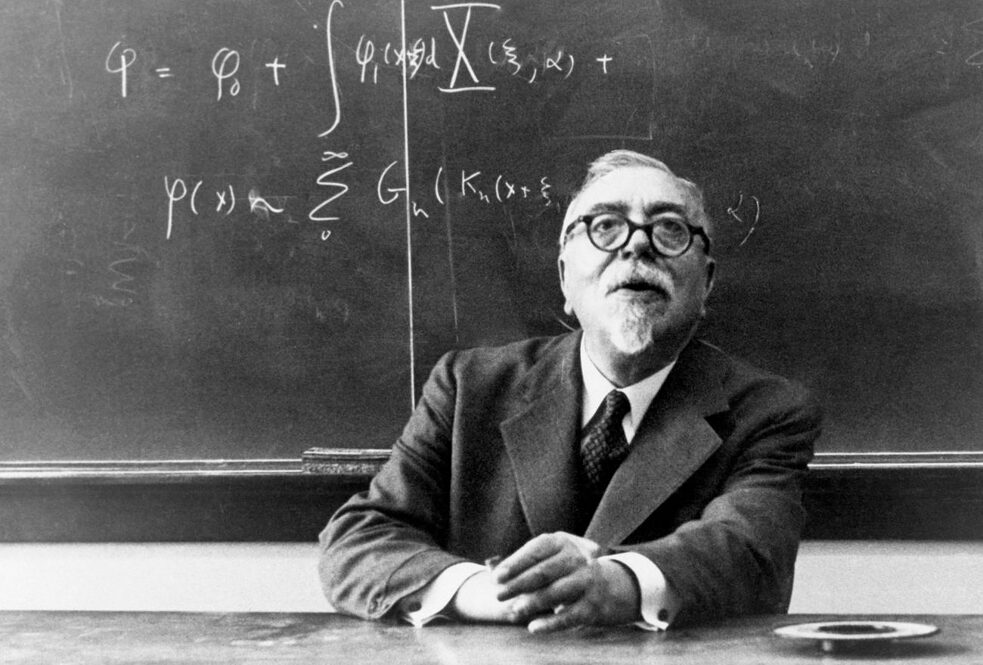 Norbert Wiener was a professor of mathematics at MIT and founded the field of cybernetics
| © Science Photo Library / Alamy Stock Photo
Norbert Wiener was a professor of mathematics at MIT and founded the field of cybernetics
| © Science Photo Library / Alamy Stock Photo
In a seemingly tangential development, von Neumann with Oskar Morgenstern wrote The Theory of Games and Economic Behaviour in 1944 which had specific Cold War applications, but was also important for AI development, particularly concerning stochastic outcomes. That is, the ability to deal with uncertainty or “chance moves” necessary to higher level machine learning.
We see this inheritance in bots, facial recognition and mass surveillance, data collection, misinformation and propaganda through social media automation. AI tends to make these processes invisible. Game theory may have the greatest impact on present-day developments in AI.
Wiener’s and von Neumann’s idea of the applicability of AI technology were, in a way, opposites. Critically, Wiener talks about the abundance of American “know-how” (including the “misfortune to discover the atomic bomb”) and too little “know-what” – understanding of purpose – and thus acceptance of “the superior dexterity of the machine-made decisions without too much inquiry as to the motives and principles behind these”. It’s an observation that still has currency.
In the 1940s both Von Neumann and Wiener described the limits of computer intelligence compared with the human brain. First, the brain doesn’t understand itself sufficiently to replicate itself. Secondly, prior to the transistor and integrated circuit chip, it was not feasible to use vacuum tubes as artificial neurons, to match the approximately 100 billion neurons of the human brain.
As Turing and the others foresaw, the intelligent machine would be a self-learning machine that could add to itself. The two central problems, human-level intelligence and machine reproducibility were technological, not conceptual, as was the case going back to the Stocking Frame. That already says much about human intelligence.
At a simpler level, chemical photography has been replaced by digital photography allowing for significant manipulations to be made to a ‘photograph’ where the idea of an original image doesn’t exist, now replaced by something that is an analogue. The same goes for film, or music recording and production.
The outcome is still determined by the creative mind of the artist, filmmaker, musician or architect, rather than a machine’s intelligence. By the mid-20th century, the mathematician’s thinking was going beyond this.
To make a distinction between first generation AI and that which mirrors the capabilities of the human brain, ‘Artificial General Intelligence’ (AGI), and further, ‘Artificial Super Intelligence’ (ASI) which surpasses the human brain, is to consider a realm where actions and decisions are given over to the machine. This is the transition from the third, to the problematics of the fourth Industrial Revolution. How will this development affect art?
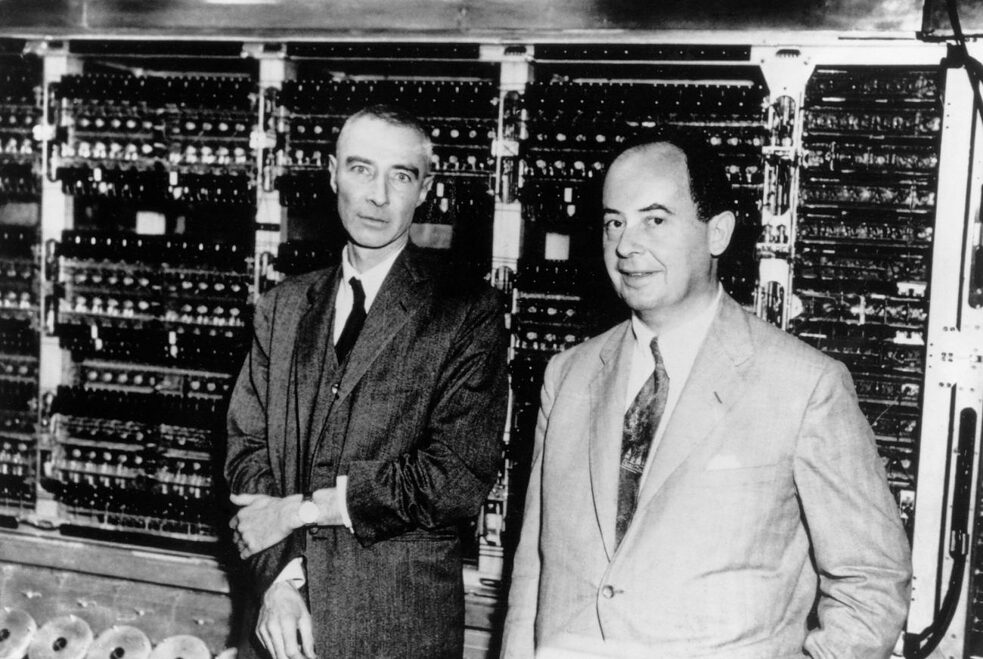 American physicists J. Robert Oppenheimer (left) and John Von Neumann (right) in front of a computer in 1952
| © Science Photo Library / Alamy Stock Photo
Artists benefit from new technologies and commonly use new devices and programs. They are early adopters. But their practice has traditionally been solo – more 16th century stocking knitter than industrial worker – although a number of artists have operated large factory-like studios with specialist departments and assistants, for example Jeff Koons, Anish Kapoor, Olafur Eliasson and even Andy Warhol. For a number of contemporary artists, the use of new technologies is closer to that of designers and architects.
American physicists J. Robert Oppenheimer (left) and John Von Neumann (right) in front of a computer in 1952
| © Science Photo Library / Alamy Stock Photo
Artists benefit from new technologies and commonly use new devices and programs. They are early adopters. But their practice has traditionally been solo – more 16th century stocking knitter than industrial worker – although a number of artists have operated large factory-like studios with specialist departments and assistants, for example Jeff Koons, Anish Kapoor, Olafur Eliasson and even Andy Warhol. For a number of contemporary artists, the use of new technologies is closer to that of designers and architects.
Many of these artists have adopted computer-aided practices, in conceptualisation and production. Jeff Koons has downsized his studio, in 2019 laying off three quarters of his 40 painting assistants – already downsized from 100 – and his sculpture/3D design department operates more as a “think tank”, automating its work and outsourcing production, using robotics and computer-operated carving machines. Although supporting the technology, he says, “It’s not about machines, it’s about using technology as a tool.”
Anish Kapoor manages a staffed complex of seven studios where he can provide schematic drawings to be elaborated with assistants. He talks about two forms as a beginning and an ending “the computer ‘imagined’ the rest”, he says. For a number of artists working is this way, their work would be inconceivable without the use of AI production. Antony Gormley’s O2 London sculpture, Quantum Cloud was created using computer algorithms relevant to the mapping of chaos theory.
The central importance of advanced computer systems is also apparent in perhaps the most art-oriented architect of the past half century, Frank Gehry. While he personally doesn’t use a computer, his work since Bilbao is dependent on CATIA, a software from Dassault Systèmes, which describes itself as “a social design environment built on a single source of truth and accessed through powerful 3D dashboards…” to create, without drawings, complex curved architectural forms
Rosemarie Trockel used computer-generated processes and machine-knitting to make ‘knitted paintings’, ironically commenting on “questionable women`s exhibitions, mostly on the theme of house and home” of the 1970s using technologies that may be identified as masculine. This she makes clear in her discussion with Isabelle Graw in Artforum in 2003: “I tried to take wool, which was viewed as a woman’s material, out of this context and to rework it in a neutral process of production.”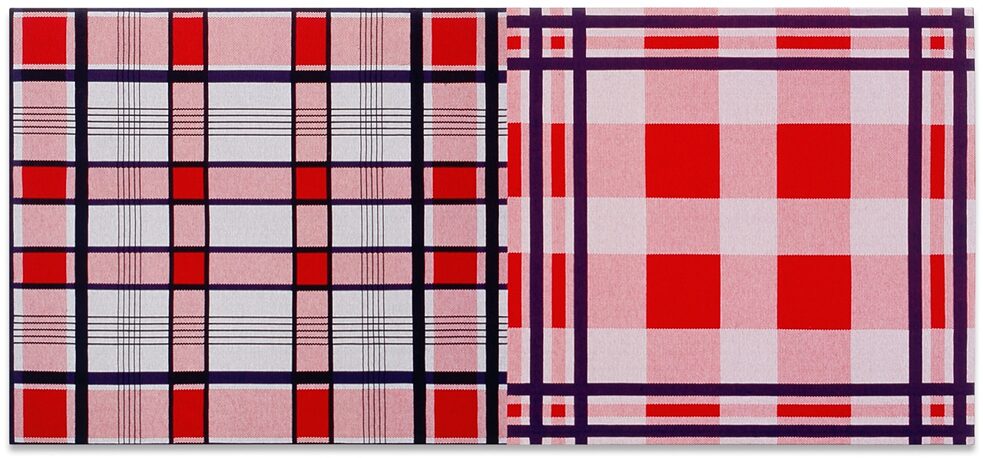 Rosemarie Trockel's "Untitled" (2002), wool (patchwork) on canvas, 180 × 400 cm
| © Rosemarie Trockel, Courtesy: Sprüth Magers
As British sculptor Tony Cragg says in Alexia Antsakli Vardinoyanni’s Artflyer interview, “You can’t ignore technology.” Against the grain, he has integrated computer technology with the hand. “But I still want to make things that I have an emotional relationship with. The computer has no psychology. It would make something and it wouldn’t mean a thing.”
Rosemarie Trockel's "Untitled" (2002), wool (patchwork) on canvas, 180 × 400 cm
| © Rosemarie Trockel, Courtesy: Sprüth Magers
As British sculptor Tony Cragg says in Alexia Antsakli Vardinoyanni’s Artflyer interview, “You can’t ignore technology.” Against the grain, he has integrated computer technology with the hand. “But I still want to make things that I have an emotional relationship with. The computer has no psychology. It would make something and it wouldn’t mean a thing.”
He no longer outsources. And here perhaps is a central question for the future of art. With more powerful AI, will art follow other managed practices – businesses and governments – of outsourcing and artists becoming information managers?
The manner and extent to which AI is used in art depends on how art and artists are defined. Let’s say art is interpretative and an artwork is a material product of a process of thinking rather than of an end-oriented object-production ‘industry’, that art is an intervention in the world and that artists mediate this relationship. In this sense art may be more like the practice of philosophy than interior decoration, where ‘objects’ or ‘situations’, rather than words, are produced.
Art has been largely unique in maintaining the intimacy of its artisanal practice while taking advantage of new technologies, and whether working in isolation or in small teams, an artist’s ‘thinking out loud’ may be done with a collaborator, a canvas or a computer. With a thing produced by human agency, intention is the governing idea. Which is to say that all art is firstly conceptual, a product of thought and, it could be argued, a good candidate for AI.
Digital technology is as available a tool as much as any other tool that might be used by an artist, from a hammer to an iPhone and further. Martin Heidegger’s term in Being and Time is ‘tool-being.’ That is, a ‘ready-to-hand’ tool and a ‘present-at-hand’ tool that is of direct use and available to our perception. To use another Heideggerian term, a work of art is ‘in-order-to’; it has a purpose, and the artist’s agency drives that purpose.
In 1991 I wrote in an essay, Education/training in/of/for/by/art, about art education that artists’ required skills are “provisional, manifold and appropriate” to diverse outcomes. I used the analogy of “the computer network or system utilised as a tool to store, shift, manipulate, produce and so on, any kind of information or thing”. Today I would add that digital technology and intelligent systems are useful tools but not replacements for ways of thinking.
The outcome is two kinds of irony concerning the amalgamation of national identity and artificial intelligence. Can a single idea of national identity – Irishness – be realised by accumulating data from the sum of its literature, films, TV, dance, art and music inserted into AI systems and constitute a coherent folk expression? Yet Imagining Ireland: A Dataset comments as much on artificial intelligence as on ideas of national identity.
The outcome is a new kind of contemporary expression, and a funny mashup exhibiting the glitches, biases and limitations of machine learning. “What I’m trying to show,” Walshe told Ireland’s Journal of Music in September this year, “is the ridiculousness of how any single idea of what nationhood is is constructed… its through all these images, these bits of film and art and music and literature, this weird composite.” Although we can’t see a performance of this work, via the YouTube link below we can see that of Walshe’s similarly complex 2019 symphony The Site of Investigation which confronts our general contemporary predicament – microplastics, Facebook likes, grief and loss, precarity, interplanetary colonisation and artificial intelligence.
Artist Mark Titmarsh, in his book Expanded Painting: Ontological Aesthetics and the Essence of Colour, writing in reference to Heidegger’s The Question Concerning Technology, puts it clearly; “making” in art “is not a kind of manufacture, but a fine tuning between human and inhuman forces, between matter and will”, and that “what comes from the act of making, is not just an object, but a showing, a revelation of the special relationship between causes.” This kind of production is at the opposite end of the spectrum to industrial processes consistent with AGI.
Functionally, art could be said to be characterised by a functional uselessness different from that produced through industrial commercial processes where function may be reduced to the economics of possession or diversion or exercised without our knowledge. The complex presence of an artwork in ‘dialogue’ with a viewer is purposive, thought-provoking and revelatory. Human agency is at both ends of the experience of art, for the artist and a viewer. There is a significant intimacy in this.
Precisely here is the question of the role of AI for art, as the autonomous agency of machine intelligence, and how artists negotiate the fourth Industrial Revolution of AGI in a world that is increasingly subject to machine-to-machine communication, automation and the internet of things, without the need for human intervention. As Heidegger says, “What is decisive ... does not lie in making … but rather in revealing ... not as manufacturing [but as] a bringing forth.” This is the artist’s job.
Learn more about Richard Dunn's views on the future of creative AI here.
To start with a brief history; AI and its variants are an outcome of the mechanisation of work. Particularly relevant is the invention of the mechanical stocking knitting machine – the Stocking Frame in 1589, and its later developments which were at the forefront of the First and Second Industrial Revolution. The Stocking Frame was the first threat to cottage industry and the handmade by mimicking the movements of hand knitters and thus it was commonly the target of the Luddites. So, it can be argued, the stocking knitting machine was the beginning of robotics.
 Installation of historic stockings and architecture at Kunstsammlungen Chemnitz, Germany
| © Richard Dunn
Installation of historic stockings and architecture at Kunstsammlungen Chemnitz, Germany
| © Richard Dunn
Stockings and computers
The mechanical knitting machines of the 19th century, driven by the steam engine, were controlled by punched tapes to make complex patterns and these were the prototypes of the computer and of data storage and algorithms to control a device. These stocking knitting machines were significant for the success of textile manufacturers in the German state of Saxony, in Chemnitz, until the 1930s. The importance of machine-made stockings to technological development leading to AI can’t be overestimated.Mid-20th century mathematicians Alan Turing, Norbert Wiener, John von Neumann, Oskar Morgenstern were critical to the next phase of the Industrial Revolution. Turing had the concept of an abstract computing machine in 1935, elaborating on the technologies of the Industrial Revolution, however most developments followed World War II. In 1948 Turing wrote in Intelligent Machinery: “What we want is a machine that can learn from experience” with the "possibility of letting the machine alter its own instructions.”
In the same year Norbert Wiener introduced cybernetics, the transdisciplinary “study of control and communication in the animal and the machine". Cybernetics, from the Greek, meaning “governance” is related to James Watt’s regulated steam engine governor, the idea of corrective feedback. This is explained in The Human Use of Human Beings: Cybernetics and Society where Wiener writes with insight about art and artists.
He supports intellectual originality and inner conviction for creative artists as much as “scientific artists” and he criticises the commodification of art, model-following art and the social prestige of higher degrees. By the 1960’s London cybernetics had considerable currency in art with, for example, Jasia Reichardt’s Cybernetic Serendipity exhibition at the Institute of Contemporary Art and artist Roy Ascott’s article Behaviourist Art and the Cybernetic Vision.
In discussing originality and the original versus the copy, Wiener brings to mind Walter Benjamin’s 1935 discussion of the aura of original works of art in his The Work of Art in the Age of Mechanical Reproduction where aura was subject to and diminished by the mechanical or technical reproducibility of photography and film.
 Norbert Wiener was a professor of mathematics at MIT and founded the field of cybernetics
| © Science Photo Library / Alamy Stock Photo
Norbert Wiener was a professor of mathematics at MIT and founded the field of cybernetics
| © Science Photo Library / Alamy Stock Photo
Game theory
It is not until the later part of Wiener’s book that he discusses automatic systems as an analogy between the human brain and electronic systems: Cybernetics applied to computer technology and learning machines, what we call ‘artificial intelligence’. However Wiener placed the machine/human dichotomy in the arena of a humane social philosophy while Wiener’s colleague, von Neumann (who had worked on the Manhattan Project) saw its military applications.In a seemingly tangential development, von Neumann with Oskar Morgenstern wrote The Theory of Games and Economic Behaviour in 1944 which had specific Cold War applications, but was also important for AI development, particularly concerning stochastic outcomes. That is, the ability to deal with uncertainty or “chance moves” necessary to higher level machine learning.
We see this inheritance in bots, facial recognition and mass surveillance, data collection, misinformation and propaganda through social media automation. AI tends to make these processes invisible. Game theory may have the greatest impact on present-day developments in AI.
Wiener’s and von Neumann’s idea of the applicability of AI technology were, in a way, opposites. Critically, Wiener talks about the abundance of American “know-how” (including the “misfortune to discover the atomic bomb”) and too little “know-what” – understanding of purpose – and thus acceptance of “the superior dexterity of the machine-made decisions without too much inquiry as to the motives and principles behind these”. It’s an observation that still has currency.
In the 1940s both Von Neumann and Wiener described the limits of computer intelligence compared with the human brain. First, the brain doesn’t understand itself sufficiently to replicate itself. Secondly, prior to the transistor and integrated circuit chip, it was not feasible to use vacuum tubes as artificial neurons, to match the approximately 100 billion neurons of the human brain.
As Turing and the others foresaw, the intelligent machine would be a self-learning machine that could add to itself. The two central problems, human-level intelligence and machine reproducibility were technological, not conceptual, as was the case going back to the Stocking Frame. That already says much about human intelligence.
Artificial intelligence and artists
Artificial intelligence – machine intelligence – is in a sense task driven, tailored to a specific function. Depending on its sophistication or on the algorithm used as a control, AI can be seen as a tool, as an aid to human-driven tasks.At a simpler level, chemical photography has been replaced by digital photography allowing for significant manipulations to be made to a ‘photograph’ where the idea of an original image doesn’t exist, now replaced by something that is an analogue. The same goes for film, or music recording and production.
The outcome is still determined by the creative mind of the artist, filmmaker, musician or architect, rather than a machine’s intelligence. By the mid-20th century, the mathematician’s thinking was going beyond this.
To make a distinction between first generation AI and that which mirrors the capabilities of the human brain, ‘Artificial General Intelligence’ (AGI), and further, ‘Artificial Super Intelligence’ (ASI) which surpasses the human brain, is to consider a realm where actions and decisions are given over to the machine. This is the transition from the third, to the problematics of the fourth Industrial Revolution. How will this development affect art?
 American physicists J. Robert Oppenheimer (left) and John Von Neumann (right) in front of a computer in 1952
| © Science Photo Library / Alamy Stock Photo
Artists benefit from new technologies and commonly use new devices and programs. They are early adopters. But their practice has traditionally been solo – more 16th century stocking knitter than industrial worker – although a number of artists have operated large factory-like studios with specialist departments and assistants, for example Jeff Koons, Anish Kapoor, Olafur Eliasson and even Andy Warhol. For a number of contemporary artists, the use of new technologies is closer to that of designers and architects.
American physicists J. Robert Oppenheimer (left) and John Von Neumann (right) in front of a computer in 1952
| © Science Photo Library / Alamy Stock Photo
Artists benefit from new technologies and commonly use new devices and programs. They are early adopters. But their practice has traditionally been solo – more 16th century stocking knitter than industrial worker – although a number of artists have operated large factory-like studios with specialist departments and assistants, for example Jeff Koons, Anish Kapoor, Olafur Eliasson and even Andy Warhol. For a number of contemporary artists, the use of new technologies is closer to that of designers and architects.Many of these artists have adopted computer-aided practices, in conceptualisation and production. Jeff Koons has downsized his studio, in 2019 laying off three quarters of his 40 painting assistants – already downsized from 100 – and his sculpture/3D design department operates more as a “think tank”, automating its work and outsourcing production, using robotics and computer-operated carving machines. Although supporting the technology, he says, “It’s not about machines, it’s about using technology as a tool.”
Anish Kapoor manages a staffed complex of seven studios where he can provide schematic drawings to be elaborated with assistants. He talks about two forms as a beginning and an ending “the computer ‘imagined’ the rest”, he says. For a number of artists working is this way, their work would be inconceivable without the use of AI production. Antony Gormley’s O2 London sculpture, Quantum Cloud was created using computer algorithms relevant to the mapping of chaos theory.
The central importance of advanced computer systems is also apparent in perhaps the most art-oriented architect of the past half century, Frank Gehry. While he personally doesn’t use a computer, his work since Bilbao is dependent on CATIA, a software from Dassault Systèmes, which describes itself as “a social design environment built on a single source of truth and accessed through powerful 3D dashboards…” to create, without drawings, complex curved architectural forms
Rosemarie Trockel used computer-generated processes and machine-knitting to make ‘knitted paintings’, ironically commenting on “questionable women`s exhibitions, mostly on the theme of house and home” of the 1970s using technologies that may be identified as masculine. This she makes clear in her discussion with Isabelle Graw in Artforum in 2003: “I tried to take wool, which was viewed as a woman’s material, out of this context and to rework it in a neutral process of production.”
 Rosemarie Trockel's "Untitled" (2002), wool (patchwork) on canvas, 180 × 400 cm
| © Rosemarie Trockel, Courtesy: Sprüth Magers
As British sculptor Tony Cragg says in Alexia Antsakli Vardinoyanni’s Artflyer interview, “You can’t ignore technology.” Against the grain, he has integrated computer technology with the hand. “But I still want to make things that I have an emotional relationship with. The computer has no psychology. It would make something and it wouldn’t mean a thing.”
Rosemarie Trockel's "Untitled" (2002), wool (patchwork) on canvas, 180 × 400 cm
| © Rosemarie Trockel, Courtesy: Sprüth Magers
As British sculptor Tony Cragg says in Alexia Antsakli Vardinoyanni’s Artflyer interview, “You can’t ignore technology.” Against the grain, he has integrated computer technology with the hand. “But I still want to make things that I have an emotional relationship with. The computer has no psychology. It would make something and it wouldn’t mean a thing.”He no longer outsources. And here perhaps is a central question for the future of art. With more powerful AI, will art follow other managed practices – businesses and governments – of outsourcing and artists becoming information managers?
The manner and extent to which AI is used in art depends on how art and artists are defined. Let’s say art is interpretative and an artwork is a material product of a process of thinking rather than of an end-oriented object-production ‘industry’, that art is an intervention in the world and that artists mediate this relationship. In this sense art may be more like the practice of philosophy than interior decoration, where ‘objects’ or ‘situations’, rather than words, are produced.
Art has been largely unique in maintaining the intimacy of its artisanal practice while taking advantage of new technologies, and whether working in isolation or in small teams, an artist’s ‘thinking out loud’ may be done with a collaborator, a canvas or a computer. With a thing produced by human agency, intention is the governing idea. Which is to say that all art is firstly conceptual, a product of thought and, it could be argued, a good candidate for AI.
Artists and agency
So, can the production of works of art be aided by digital processes? Absolutely! As a user of computer technology since the mid-1980s and a long-time user of Photoshop and Final Cut Pro, computer use is central to my own practice. Now Adobe has added AI-powered tools developed for gamers to Photoshop and their Sensei software uses AI and machine learning for ‘effortless creation’ in video production. Increasingly, machine learning raises the question of the balance in autonomy of authorship and control.Digital technology is as available a tool as much as any other tool that might be used by an artist, from a hammer to an iPhone and further. Martin Heidegger’s term in Being and Time is ‘tool-being.’ That is, a ‘ready-to-hand’ tool and a ‘present-at-hand’ tool that is of direct use and available to our perception. To use another Heideggerian term, a work of art is ‘in-order-to’; it has a purpose, and the artist’s agency drives that purpose.
In 1991 I wrote in an essay, Education/training in/of/for/by/art, about art education that artists’ required skills are “provisional, manifold and appropriate” to diverse outcomes. I used the analogy of “the computer network or system utilised as a tool to store, shift, manipulate, produce and so on, any kind of information or thing”. Today I would add that digital technology and intelligent systems are useful tools but not replacements for ways of thinking.
An artificially intelligent artwork?
Good recent examples of AI-data generated artworks are the new music pieces by the Irish classical composer Jennifer Walshe. Her most recent 2020 radiophonic play Imagining Ireland: A Dataset is constructed from many versions of ‘Irishness’ fed into a dataset.The outcome is two kinds of irony concerning the amalgamation of national identity and artificial intelligence. Can a single idea of national identity – Irishness – be realised by accumulating data from the sum of its literature, films, TV, dance, art and music inserted into AI systems and constitute a coherent folk expression? Yet Imagining Ireland: A Dataset comments as much on artificial intelligence as on ideas of national identity.
The outcome is a new kind of contemporary expression, and a funny mashup exhibiting the glitches, biases and limitations of machine learning. “What I’m trying to show,” Walshe told Ireland’s Journal of Music in September this year, “is the ridiculousness of how any single idea of what nationhood is is constructed… its through all these images, these bits of film and art and music and literature, this weird composite.” Although we can’t see a performance of this work, via the YouTube link below we can see that of Walshe’s similarly complex 2019 symphony The Site of Investigation which confronts our general contemporary predicament – microplastics, Facebook likes, grief and loss, precarity, interplanetary colonisation and artificial intelligence.
Artist Mark Titmarsh, in his book Expanded Painting: Ontological Aesthetics and the Essence of Colour, writing in reference to Heidegger’s The Question Concerning Technology, puts it clearly; “making” in art “is not a kind of manufacture, but a fine tuning between human and inhuman forces, between matter and will”, and that “what comes from the act of making, is not just an object, but a showing, a revelation of the special relationship between causes.” This kind of production is at the opposite end of the spectrum to industrial processes consistent with AGI.
Functionally, art could be said to be characterised by a functional uselessness different from that produced through industrial commercial processes where function may be reduced to the economics of possession or diversion or exercised without our knowledge. The complex presence of an artwork in ‘dialogue’ with a viewer is purposive, thought-provoking and revelatory. Human agency is at both ends of the experience of art, for the artist and a viewer. There is a significant intimacy in this.
Precisely here is the question of the role of AI for art, as the autonomous agency of machine intelligence, and how artists negotiate the fourth Industrial Revolution of AGI in a world that is increasingly subject to machine-to-machine communication, automation and the internet of things, without the need for human intervention. As Heidegger says, “What is decisive ... does not lie in making … but rather in revealing ... not as manufacturing [but as] a bringing forth.” This is the artist’s job.
Learn more about Richard Dunn's views on the future of creative AI here.
